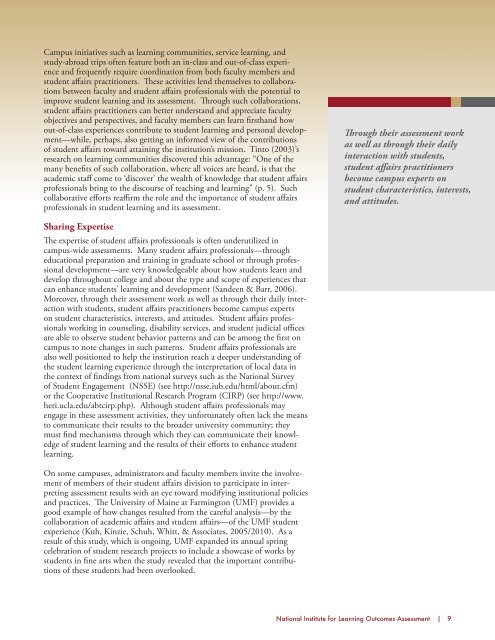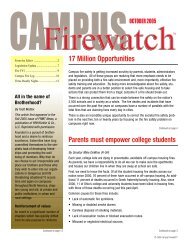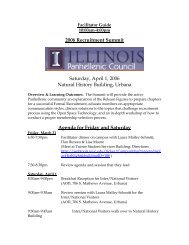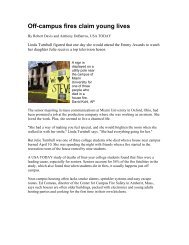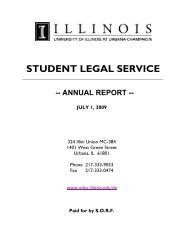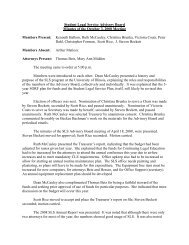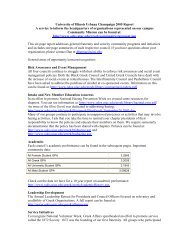StudentAffairsRole in Assessment - Office of the Dean of Students ...
StudentAffairsRole in Assessment - Office of the Dean of Students ...
StudentAffairsRole in Assessment - Office of the Dean of Students ...
Create successful ePaper yourself
Turn your PDF publications into a flip-book with our unique Google optimized e-Paper software.
Campus <strong>in</strong>itiatives such as learn<strong>in</strong>g communities, service learn<strong>in</strong>g, and<br />
study-abroad trips <strong>of</strong>ten feature both an <strong>in</strong>-class and out-<strong>of</strong>-class experience<br />
and frequently require coord<strong>in</strong>ation from both faculty members and<br />
student affairs practitioners. These activities lend <strong>the</strong>mselves to collaborations<br />
between faculty and student affairs pr<strong>of</strong>essionals with <strong>the</strong> potential to<br />
improve student learn<strong>in</strong>g and its assessment. Through such collaborations,<br />
student affairs practitioners can better understand and appreciate faculty<br />
objectives and perspectives, and faculty members can learn firsthand how<br />
out-<strong>of</strong>-class experiences contribute to student learn<strong>in</strong>g and personal development—while,<br />
perhaps, also gett<strong>in</strong>g an <strong>in</strong>formed view <strong>of</strong> <strong>the</strong> contributions<br />
<strong>of</strong> student affairs toward atta<strong>in</strong><strong>in</strong>g <strong>the</strong> <strong>in</strong>stitution’s mission. T<strong>in</strong>to (2003)’s<br />
research on learn<strong>in</strong>g communities discovered this advantage: “One <strong>of</strong> <strong>the</strong><br />
many benefits <strong>of</strong> such collaboration, where all voices are heard, is that <strong>the</strong><br />
academic staff come to ‘discover’ <strong>the</strong> wealth <strong>of</strong> knowledge that student affairs<br />
pr<strong>of</strong>essionals br<strong>in</strong>g to <strong>the</strong> discourse <strong>of</strong> teach<strong>in</strong>g and learn<strong>in</strong>g” (p. 5). Such<br />
collaborative efforts reaffirm <strong>the</strong> role and <strong>the</strong> importance <strong>of</strong> student affairs<br />
pr<strong>of</strong>essionals <strong>in</strong> student learn<strong>in</strong>g and its assessment.<br />
Through <strong>the</strong>ir assessment work<br />
as well as through <strong>the</strong>ir daily<br />
<strong>in</strong>teraction with students,<br />
student affairs practitioners<br />
become campus experts on<br />
student characteristics, <strong>in</strong>terests,<br />
and attitudes.<br />
Shar<strong>in</strong>g Expertise<br />
The expertise <strong>of</strong> student affairs pr<strong>of</strong>essionals is <strong>of</strong>ten underutilized <strong>in</strong><br />
campus-wide assessments. Many student affairs pr<strong>of</strong>essionals—through<br />
educational preparation and tra<strong>in</strong><strong>in</strong>g <strong>in</strong> graduate school or through pr<strong>of</strong>essional<br />
development—are very knowledgeable about how students learn and<br />
develop throughout college and about <strong>the</strong> type and scope <strong>of</strong> experiences that<br />
can enhance students’ learn<strong>in</strong>g and development (Sandeen & Barr, 2006).<br />
Moreover, through <strong>the</strong>ir assessment work as well as through <strong>the</strong>ir daily <strong>in</strong>teraction<br />
with students, student affairs practitioners become campus experts<br />
on student characteristics, <strong>in</strong>terests, and attitudes. Student affairs pr<strong>of</strong>essionals<br />
work<strong>in</strong>g <strong>in</strong> counsel<strong>in</strong>g, disability services, and student judicial <strong>of</strong>fices<br />
are able to observe student behavior patterns and can be among <strong>the</strong> first on<br />
campus to note changes <strong>in</strong> such patterns. Student affairs pr<strong>of</strong>essionals are<br />
also well positioned to help <strong>the</strong> <strong>in</strong>stitution reach a deeper understand<strong>in</strong>g <strong>of</strong><br />
<strong>the</strong> student learn<strong>in</strong>g experience through <strong>the</strong> <strong>in</strong>terpretation <strong>of</strong> local data <strong>in</strong><br />
<strong>the</strong> context <strong>of</strong> f<strong>in</strong>d<strong>in</strong>gs from national surveys such as <strong>the</strong> National Survey<br />
<strong>of</strong> Student Engagement (NSSE) (see http://nsse.iub.edu/html/about.cfm)<br />
or <strong>the</strong> Cooperative Institutional Research Program (CIRP) (see http://www.<br />
heri.ucla.edu/abtcirp.php). Although student affairs pr<strong>of</strong>essionals may<br />
engage <strong>in</strong> <strong>the</strong>se assessment activities, <strong>the</strong>y unfortunately <strong>of</strong>ten lack <strong>the</strong> means<br />
to communicate <strong>the</strong>ir results to <strong>the</strong> broader university community; <strong>the</strong>y<br />
must f<strong>in</strong>d mechanisms through which <strong>the</strong>y can communicate <strong>the</strong>ir knowledge<br />
<strong>of</strong> student learn<strong>in</strong>g and <strong>the</strong> results <strong>of</strong> <strong>the</strong>ir efforts to enhance student<br />
learn<strong>in</strong>g.<br />
On some campuses, adm<strong>in</strong>istrators and faculty members <strong>in</strong>vite <strong>the</strong> <strong>in</strong>volvement<br />
<strong>of</strong> members <strong>of</strong> <strong>the</strong>ir student affairs division to participate <strong>in</strong> <strong>in</strong>terpret<strong>in</strong>g<br />
assessment results with an eye toward modify<strong>in</strong>g <strong>in</strong>stitutional policies<br />
and practices. The University <strong>of</strong> Ma<strong>in</strong>e at Farm<strong>in</strong>gton (UMF) provides a<br />
good example <strong>of</strong> how changes resulted from <strong>the</strong> careful analysis—by <strong>the</strong><br />
collaboration <strong>of</strong> academic affairs and student affairs—<strong>of</strong> <strong>the</strong> UMF student<br />
experience (Kuh, K<strong>in</strong>zie, Schuh, Whitt, & Associates, 2005/2010). As a<br />
result <strong>of</strong> this study, which is ongo<strong>in</strong>g, UMF expanded its annual spr<strong>in</strong>g<br />
celebration <strong>of</strong> student research projects to <strong>in</strong>clude a showcase <strong>of</strong> works by<br />
students <strong>in</strong> f<strong>in</strong>e arts when <strong>the</strong> study revealed that <strong>the</strong> important contributions<br />
<strong>of</strong> <strong>the</strong>se students had been overlooked.<br />
National Institute for Learn<strong>in</strong>g Outcomes <strong>Assessment</strong> | 9


